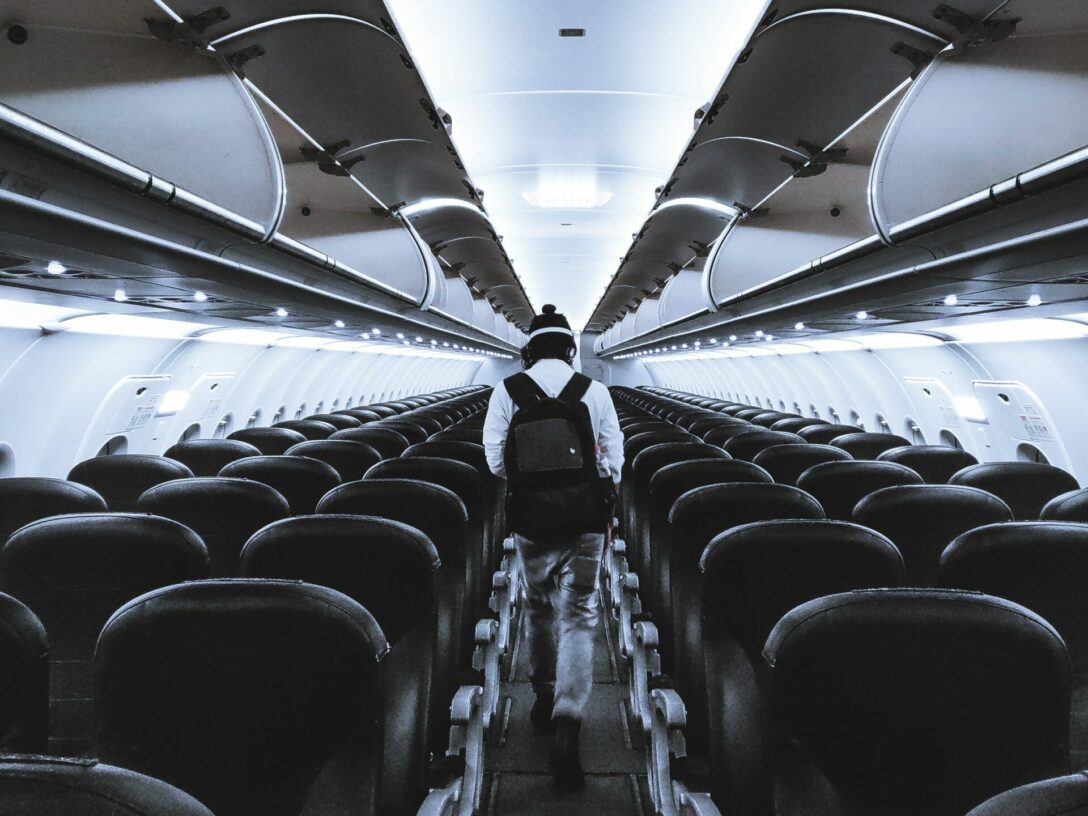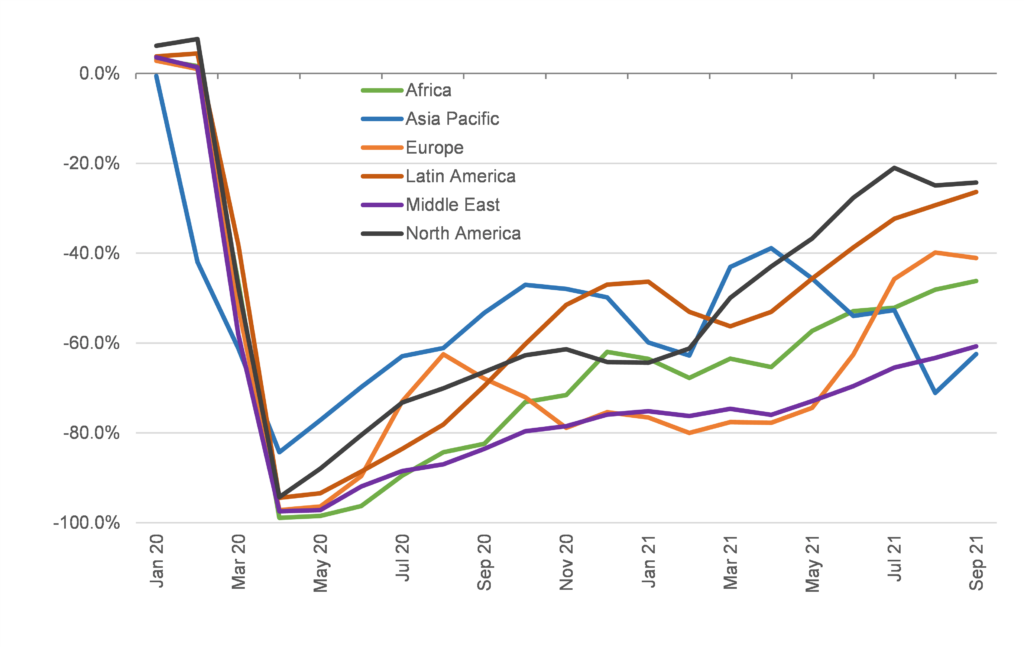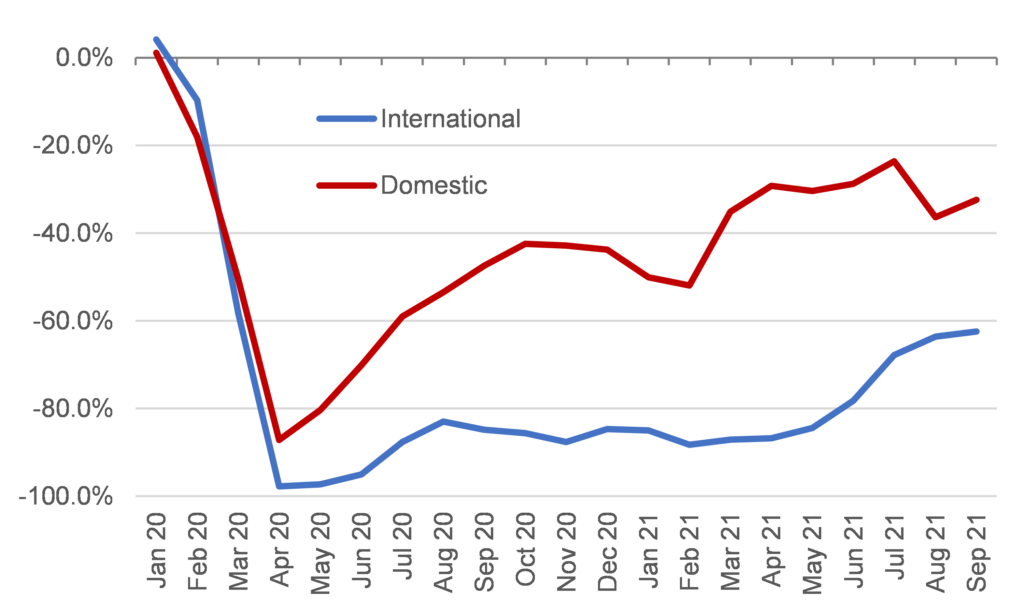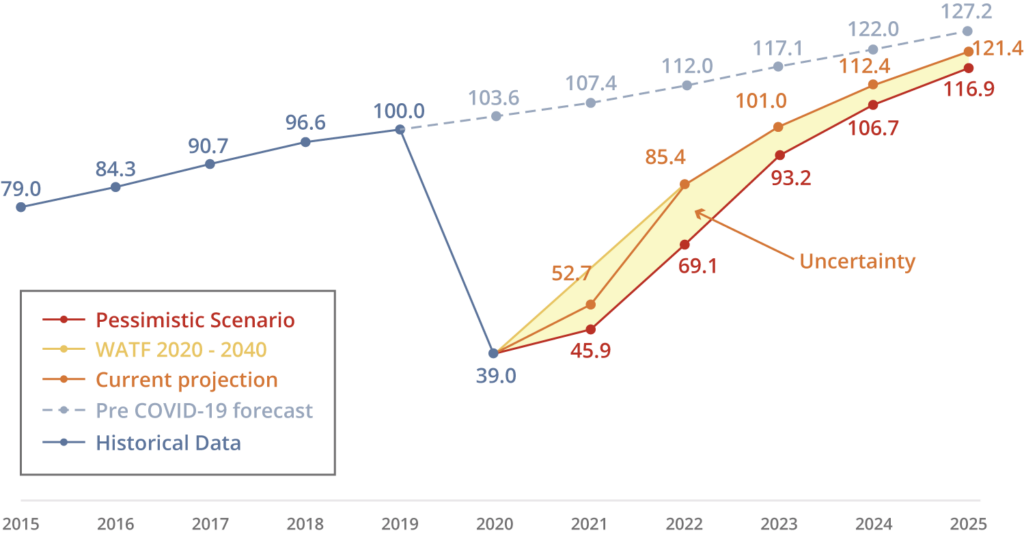Global Aviation Industry: Effect and Recovery Outlook of the COVID-19 Pandemic

The COVID-19 pandemic resulted in an unprecedented collapse in the global aviation industry. This piece examines the state of the aviation industry outside of North America, a year and half after the start of the pandemic and considers the outlook for recovery.
Traffic Developments
It is no news that air travel across the globe collapsed in April 2020 as governments put in place restrictions or banned international travel in an attempt to control the spread of COVID-19. As shown in figure 1 below, all regions experienced a precipitous drop in traffic by April 2020 and while none have yet to recover to 2019 levels, the recovery has been generally, if slowly, upward trending.
Figure 1: Monthly Passenger Traffic vs 2019 by Region

As recovery slowly resumes, it is apparent that domestic traffic has led the recovery, as illustrated in the figure 2 below. Like the U.S., other large domestic markets such as China, India, Indonesia, Japan and Australia began their recovery as governments removed or reduced restrictions on internal traffic (in some markets, such as Japan and Australia, this recovery has been interrupted by the re-imposition of restrictions to minimise the resurgence of the virus). While international travel picked up slightly in summer 2020 as lock down restrictions were relaxed (most notably in Europe), the recovery stalled as restrictions were reapplied with the second and third wave of COVID-19. International travel has started to pick this summer with the roll-out of vaccines leading to countries loosening travel rules.
Figure 2: Global Monthly Passenger Traffic vs 2019, Domestic and International

Challenges to Recovery
The difference between domestic and international traffic recovery illustrates the key challenge to global air traffic recovery – government restrictions and controls on international travel. As of July 2021, the United Nations World Tourism Organization (UN WTO) reported that 29% of destinations worldwide remained completely closed to tourists, 34% had partially closures and 36% required negative COVID-19 test results upon arrival (sometimes combined with quarantine requirements).[1] There are considerable regional differences – 70% of Asia Pacific destinations remained closed compared with 20% in the Americas and 13% in Europe. The UN WTO reported that only three countries had no COVID restrictions on international travel – Albania, Costa Rica and the Dominican Republic. The issue for travellers is not just restrictions at the destination but also restriction imposed on outbound travel in their home countries, with some destination countries red-listed or travellers requiring testing and quarantining upon return.
The good news is that restrictions are being lifted (or reduced) as vaccination programmes in some countries have reduced the spread and severity of the virus. The U.S. will reopen to fully vaccinated travellers from 33 countries including much of Europe, China and India. The UK and European Union have also started to relax restrictions on inbound and outbound travel. However, there is still some way to go before situation resembles “back to normal”. As the International Air Transport Association ( IATA) has pointed out, there is lack of agreement between countries on the recognition of vaccines approved by the World Health Organisation, traveller testing requirements and documentation to certify full vaccination. A further challenge is that vaccination rates vary considerable across the globe – in Europe 53% of the population is fully vaccinated, while North America has a similar rate of 48%, but in Asia the figure is 38% and in Africa only 4.6% have been fully vaccinated.[2]
Recovery Outlook
Clearly, there is still considerable uncertainty about path of recovery for air traffic. While recent trends in international traffic have been positive, differences in vaccination rates and concerns about further waves of the outbreak and the emergence of new variants are likely to shape government policy for some time. As the aviation industry has been pushing, the approach taken needs to be smarter and more targeted and should reflect the fact that vaccinated travellers pose a much smaller risk to public health. A key positive is that there still seems to be strong appetite for air travel – IATA reported that ticket sales from the EU to the U.S. increased by a factor of 2.4 following the announcement that the U.S. was removing restrictions on travel.[3] Similar surges in bookings have been reported elsewhere following the relaxation of restrictions. The outlook for the global economy is generally positive – the World Bank is forecasting that world GDP will increase 5.6% in 2021 and 4.3% in 2022 (following a decline of 3.5% in 2020).[4] It is hoped that this will translate in increasing demand for air travel as travel restrictions recede. However, there are economic headwinds coming from rising inflation, supply chain disruptions and sharp rises in energy prices.
While forecasts of global air traffic recovery are updated regularly, there is generally consensus that recovery to 2019 levels will take several more years overall. This is illustrated in the chart below which shows the Airports Council International (ACI) most recent forecasts for global passenger traffic. The forecast anticipates recovery to 2019 levels by 2023 (2024 in the pessimistic forecast), although this will still be some way off the pre-COVID trend. Obviously, the timing of the recovery will be different for different regions and for individual airports, depending on what travel restrictions will apply, local economic conditions and traffic mix.
Figure 3: Global Passenger Traffic Projections (Indexed, 2019=100)

Our next insight post will feature recovery outlook for the Canadian aviation industry.
[1] https://www.unwto.org/news/vaccines-and-digital-solutions-to-ease-travel-restrictions.
[2] https://ourworldindata.org/covid-vaccinations, pulled 8 October 2021. Figure based on total population including children (some new outlets report percentage of adult population vaccinated which is generally a higher percentage).
[3] https://www.iata.org/en/iata-repository/publications/economic-reports/us-europe-reopening-followed-by-surge-in-bookings/.
[4] https://www.worldbank.org/en/publication/global-economic-prospects.
Contact Us
Ready to get started? Let’s work together on finding solutions that work for you. Get in touch and let us know how we can help!
Contact Us
